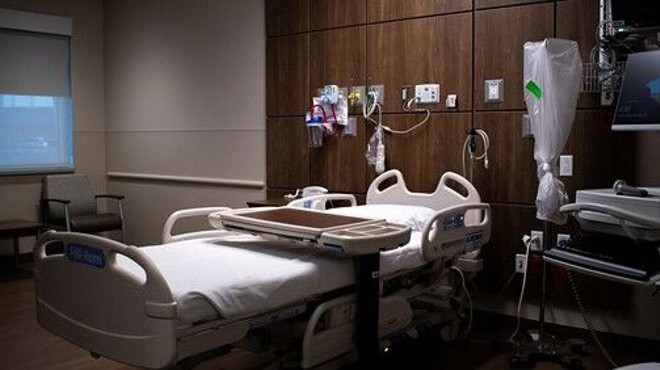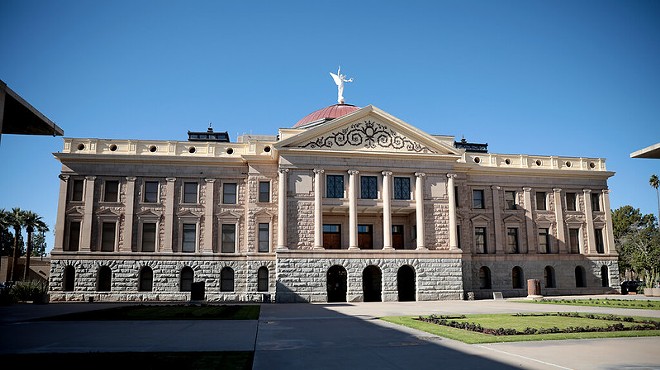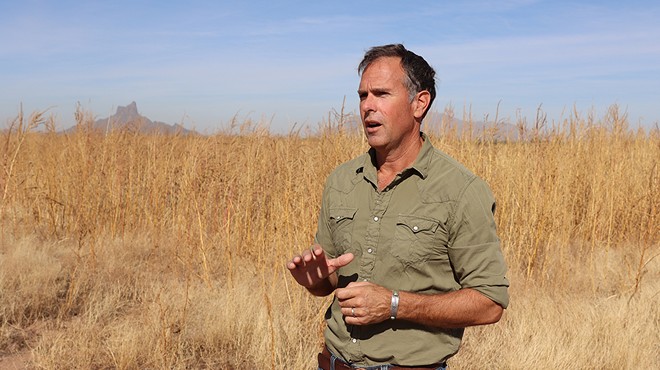Monday, August 6, 2012
This Is What It Looks Like When You're Falling out of the Sky on Mars

- NASA/JPL-Caltech/University of Arizona
- During its descent, Curiosity was able to shoot a photo of its own heat shield shortly after it had been jettisoned.
NASA released a new batch of photos from the Curiosity rover following the Mars Science Laboratory's landing in Gale Crater yesterday. The above photo was taken as the robotic lab was rushing toward the Martian surface and had jettisoned its heat shield.
Meanwhile, Dan Stolte of UA News brings us more details about the astonishing work that the UA Lunar and Planetary Lab's HiRISE team did in capturing a picture of Curiosity's descent:
Dangling from its parachute, Mars rover Curiosity was photographed by the UA-led HiRISE camera aboard NASA's Mars Reconnaissance Orbiter. HiRISE images will serve as road maps once the rover sets out to explore Gale Crater.In a carefully choreographed maneuver high in the sky above Mars, two man-made spacecraft zipped past each other as NASA scientists and engineers stared at screens inside Mission Control at NASA's Jet Propulsion Laboratory, anxiously enduring the "7 minutes of terror"—the time it would take the Curiosity rover to plunge into Mars' atmosphere and touch down on the bottom of Gale Crater near the Martian equator.
While Curiosity—the centerpiece of the Mars Science Laboratory Mission, or MSL—hurtled toward the ground at twice the speed of sound, another spacecraft, NASA's Mars Reconnaissance Orbiter, or MRO, pointed its HiRISE camera at Curiosity and snapped a photo of the spacecraft with the rover tucked inside, suspended from its 50-foot-diameter parachute. HiRISE stands for High-Resolution Imaging Science Experiment.
"We have been planning this for some time," said Alfred McEwen, a professor in the University of Arizona Lunar and Planetary Laboratory and principal investigator of the HiRISE mission. "We gradually adjusted MRO's orbit to make sure it would be right over Curiosity as it landed, and that put us in a great position for this image. It came back exactly as we expected in terms of brightness and contrast. The parachute looked beautiful, nice and sharp, fully inflated and working perfectly."
The snap shot required months of preparations to make sure the two spacecraft, traveling in directions perpendicular to each other and at several miles per second in the case of MRO, wouldn't miss each other. McEwen said it would have been great to have the descent image in color, but because HiRISE's color channel has a narrower field of view than the black and white channels, that wasn't possible under the circumstances. "It's a good thing our field of view wasn¹t very much narrower or we could have missed it entirety," McEwen said.
"Touch-down confirmed. We're safe on Mars!" The announcement, shortly after 10:30 p.m. on Aug. 5, sent Mission Control into cheering and high-fiving.
No other planet has claimed as many spacecraft in its 50 years of exploration, said Shane Byrne, an assistant professor in the UA department of planetary sciences. More than half of the 40 attempts to land a probe on the Red Planet failed, either never making it out of Earth¹s orbit or crashing and burning upon arrival.
“The successful landing of rover Curiosity gets us one closer to tying the score,” said Byrne, adding that landing on Mars is no easy feat. “Previous attempts have shown that you can go hundreds of millions of miles only to trip on your shoe laces.”
The latest and greatest in a series of Mars exploration vehicles owes its safe touchdown on the floor of Gale Crater near the Martian equator in no small way to the data gathered by the UA-led HiRISE camera, which has been photographing Mars aboard NASA¹s Mars Reconnaissance Orbiter for the past six years.
Selecting a landing site for Curiosity that is both safe to touch down and promising to yield as much scientific insight as possible would not have been possible without the high-resolution images taken by HiRISE.
“HiRISE imaged all potential landing sites that were being discussed,” said Byrne, who is a co-investigator on the HiRISE team. “By the time it came down to four candidate sites, we had wall-to-wall covering of all the areas in question.”
Powerful enough to reveal details on the surface the size of a coffee table, HiRISE has returned about 26,000 images so far, less than 2 percent of the Martian surface. But Byrne said that what has been imaged so far has been chosen carefully.
He explained that although Mars is smaller than the Earth, its surface area is comparable to Earth¹s when combining the landmass of all continents and leaving out the oceans.
“Mars is a big place with lots to see. Some areas are uniform and boring, but there are others like the Grand Canyon. HiRISE has focused on the most interesting and most informative sites.”
HiRISE has flown over and photographed some sites over and over again to document seasonal changes and help scientists better understand how the climate on Mars varies from year to year. By repeatedly imaging a site from different viewing angles, the HiRISE team can assemble three-dimensional images of the Martian terrain.
The resulting images, called digital terrain models, will serve as roadmaps for the Curiosity rover as it slowly rolls across the Martian soil.
“HiRISE data helps the Curiosity team plan the traverses the rover will take,” Byrne said. “These data help the engineers choose how to best get from A to B.”
He added that with the two high-resolution cameras mounted atop its mast just shy of 7 feet, Curiosity can see quite a long distance, and make out features HiRISE can¹t.
“As the mission develops, I expect Curiosity¹s routes to be constantly revised. HiRISE is going to give the team the first cut, but when it comes to day-to-day details like avoiding rocks, they will rely on the rover¹s onboard cameras.”
Scouting out safe passages is crucial. Opportunity, one of an identical pair of NASA¹s Mars Exploration Rovers, once got stuck in what the mission team called the “purgatory” a dune field with waist-high ripples of sand. It took weeks of maneuvering to guide the vehicle back onto firm ground.
“HiRISE has been able to help NASA avoid similar situations and allows them to plan out safe yet interesting routes,” Byrne said. “It¹s the only instrument that can resolve boulders as small as 3 feet.”
When the stationary lander Phoenix was sent to Mars several years ago, it was already approaching the planet when engineers changed the landing site when HiRISE reconnaissance revealed the landing spot it was approaching was littered with rocks not seen in previous images.
“With HiRISE, we were able to avert a potential crash,” Byrne said.
“Phoenix set the stage for the Mars Science Laboratory mission,” said Peter Smith of the UA¹s Lunar and Planetary Laboratory who is the principal investigator of the Phoenix Mars Mission, the first and only NASA mission ever to be led by a public university.
He remembers his time as team leader of the Mars Pathfinder Mission in 1997, when NASA landed rover Sojourner on Mars, which looks like a toy next to Curiosity.
A stationary camera on the lander guided the roughly breadbox-sized Sojourner rover. This camera, called Imager for Mars Pathfinder, was designed and built at the UA.
“Sojourner managed to drive about 50 meters around the lander in three months,” Smith said. “All it could do is roll up to nearby rocks and determine their composition.”
“It¹s been a tremendous thrill to be part of this keeping in mind that it was only eight years ago that we sent autonomous rovers to Mars that carried everything they needed with them,” Smith said, pointing out that Opportunity has explored a lot of terrain, able to drive down into craters, explore the side walls up close and then move on to the next crater.
“And now we sent a car-sized, nuclear powered rover, and we landed it in a really interesting area.”
Smith said the Phoenix and MSL missions complement each other, with Phoenix digging into the permafrost soil to explore the chemistry and mineral composition in Mars¹ North Polar Region and MSL probing the chemistry and minerals in the equatorial region.
“With Phoenix, we are looking for current habitability,” Smith said. “In other words, are the polar regions on Mars like deep freezers of the planet where life could have been preserved, similarly to Antarctica? Curiosity, on the other hand, is looking for habitability of ancient Mars, something we couldn¹t do with Phoenix. Curiosity will look at exposed layers that may reveal clues to if and how life could have existed on Mars in the past.”
McEwen said that with the rover safely on the ground, HiRISE will look for the rover and the other parts of the spacecraft.
"We¹re going to take another image tonight or early tomorrow of Curiosity on the ground," he said, adding that there is more to look for.
"In past missions, there was a rover, a heat shield and the shell attached to the parachute. With Curiosity, we have additional components like the sky crane that lowered the rover onto the ground, and ballast that dropped off some distance to the east. Those should have come in at high enough impact to make craters."
McEwen said he just received notice that the heat shield may have been located in one of the images HiRISE transmitted back to Earth, as it was still falling.
And with reference to the HiRISE image capturing the Phoenix Mars Lander parachuting to the surface in May 2008, he added: “We¹re two for two. Every time we image, it¹s a successful landing."

- NASA/JPL-Caltech/University of Arizona
- Curiosity sees its own shadow—and the looming mountain in Gale Crater that NASA hopes to explore
Tags: Arizona news , Tucson news , Curiosity , HiRISE , NASA , descent , UA Lunar and Planetary Lab


















